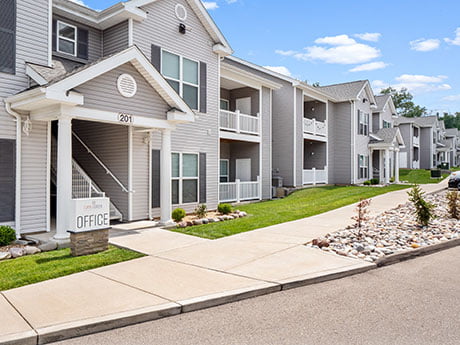06.24.21
Demand for Value-Add Multifamily Acquisitions Outpaces Supply

Earlier this year, national real estate investor and operator Waterton closed fundraising activity for a multifamily value-add fund with $1.5 billion in equity commitments from global institutional investors. Waterton launched the fund, known as Waterton Residential Property Venture XIV, in May 2020.
The first deployment from the fund was a four-property, 1,824-unit portfolio in metro Atlanta followed by a two-property portfolio in Hawaii and three assets in California. The largest-ever fund from Waterton will continue to target both urban and suburban assets in major U.S. markets.
The value-add investment strategy is nothing new for Waterton. The Chicago-based company has taken this approach for the last 25 years. But today there is strong demand among investors to be in the multifamily sector, says Rick Hurd, chief investment officer.
As a result of the COVID-19 pandemic, some acquisitions are what Hurd calls “urban distress.” In other words, Waterton is making investments in areas like downtown Los Angeles and San Francisco in anticipation that demand will come back to the urban core over the next couple years. Many renters have migrated to the suburbs during the pandemic to be away from densely populated areas.
According to Hurd, there is currently significant demand for suburban assets in markets across the Southeast and Southwest. “Everyone is seeking that value-add, suburban strategy right now because urban assets are harder to stabilize given lower occupancies.”
That said, Hurd believes that the key to multifamily investment is diversification and owning assets in several markets. Each year, Waterton will upgrade about 2,000 to 3,000 apartment units. The goal with each property is to achieve a 15 to 20 percent return on investment (ROI). That typically translates to a monthly rent increase of $150 to $200 per unit.
ROI of 15 to 20 percent is also what Chicago-based Peak Properties LLC seeks to achieve after completing renovations. But the ability to raise rents depends on the market and other factors. For instance, sometimes a unit is so old that the improvements don’t result in much of a rent increase. Additionally, the ROI on a vacant unit is zero, says Mike Zucker, managing partner.
Peak has spent between $10,000 to $75,000 per unit for renovations. The expenses depend on the condition of the property and the acquisition strategy, according to Zucker. A typical renovation for the company consists of installing new kitchens and baths, new floors, upgraded plumbing and electrical fixtures, plus the addition of washers and dryers whenever possible.
The financing of a value-add project typically involves using a floating-rate loan for the construction period before a permanent loan is put in place once the renovation work is complete, according to Zucker. However, his firm has undertaken deals where it has locked in the rate during the construction period and committed to the bank for the permanent loan.
Interest rates have moved almost one full point since the historic lows of six months ago, which is a “difference maker,” says Zucker. “The deals that were in the ‘maybe’ category are now off the list. All our models run loans now of at least 4 to 5 percent.”
Due to the rising interest rate environment, investors are seeking the cheapest fixed-rate debt available in order to minimize interest rate risk, says Danny Mantis, advisor with Chicago-based Kiser Group. “With that said, money is still cheap by historical standards and conventional wisdom is that rates will push higher over the next few years,” he says.
The value-add spectrum
For Ted Stratman, managing partner with Chicago-based Interra Realty, the term “value-add” is broad-ranging. From 2010 to 2013, most of the value-add multifamily properties he sold were almost completely vacant and in need of a top-to-bottom renovation. Now, while gut rehabs still exist, there are more buyers looking to renovate and reposition occupied buildings. They update finishes and add amenities to underutilized spaces as units turn over.
Mantis says it’s really important to understand what a buyer’s strategy is because value-add can take on many different meanings. “Oftentimes, we think of value-add as a rehab, where an investor will vacate units, remodel and re-lease the renovated units at a higher rent, and then refinance to take cash out of the property,” says Mantis. “That’s only one strategy, though.”
In the fourth quarter of 2020, Mantis arranged two deals in which the buyers were motivated to take advantage of low interest rates and implement what Mantis calls a “management value-add” as opposed to a typical value-add project. In other words, the buyers planned to raise rents or add additional revenue streams with minimal focus on remodeling unit interiors.
Mantis says there will always be a strong appetite for a value-add deal that involves cosmetic updates rather than one that requires plumbing and electrical work be done. “The heavier the value-add, the deeper the discount a buyer will expect.”
Vinan Apartments in Melrose Park, a suburb of Chicago, sold to a buyer that identified cost savings simply by choosing to own the laundry equipment as opposed to leasing washers and dryers. The purchaser also installed zone valves for boilers. This specific type of valve is used to control the flow of water or steam in an effort to improve efficiency. According to Mantis, this transaction is a good example of how a thoughtful investor can successfully execute a value-add strategy by controlling expenses rather than by increasing revenues.
What’s fueling demand?
Most investors like to see ROI at or above 20 percent on value-add acquisitions, says Jason Krug, managing director in Berkadia’s Southfield, Michigan office. While monthly rental rate increases can range anywhere from $50 to $400 depending on the scope of the renovations, the average is $150 to $200.
Krug recently brokered the sale of a two-property, 840-unit portfolio in Michigan. The seller renovated about 38 percent of the units and was achieving premiums on those units of $275 to $325 per month and an ROI north of 25 percent. The new buyer plans to continue the value-add renovations in light of the successful execution by the seller, according to Krug.
“Today, we are experiencing an all-time high demand for value-add opportunities with a scarcity of available assets,” says Krug. “An uptick in the 10-year Treasury [yield] has caused some pause, but there is still far more demand that has not yet been satisfied.”
Ted Abramson, senior vice president with CBRE in Minneapolis, echoes that sentiment. “Demand from buyers is at very strong levels. Depending on the market, demand is as competitive, if not more competitive, than prior to the pandemic.”
Abramson’s team recently arranged the sale of a value-add opportunity in Cottage Grove, a suburb of the Twin Cities. The 249-unit Hinton Heights received 17 bids from prospective buyers before being sold to Oak Residential Partners.
There is currently a shortage of quality properties in the value-add market, yet capital continues to grow in the space, says Kevin Dillon, senior managing director with Berkadia in Southfield, Michigan. The net effect is a very strong seller’s market, he says.
“The pandemic was favorable to this market. Tenants needed a place to live and wanted an apartment that had been updated but did not have the same cost as a new property,” says Dillon.
In general, apartment occupancies remained “remarkably stable” throughout 2020, reports Reis, a commercial real estate research firm. The national vacancy rate at the end of the year stood at 5.2 percent, an increase of 50 basis points year-over-year and an increase of 10 basis points from the third quarter.
Kevin Beard, director of acquisitions for Chicago-based Evergreen Real Estate Group, says that the demand for multifamily investment is fueled by low interest rates, generally strong collections and equity flowing away from other property types as a result of the pandemic.
Mantis says that the low interest rates, stable rent collections and lack of inventory on the market have contributed to the multifamily sector remaining a “resilient asset class” throughout the pandemic. “In my view, these three factors have mitigated the economic uncertainty created by the pandemic but not superseded it, meaning that while we haven’t seen cap rate expansion, we haven’t seen cap rate compression either,” he says.
While the past year certainly has been challenging for owners and operators, if they are considering a possible sale of a property or portfolio the current conditions are favorable for achieving a healthy price, according to Stratman.
Stratman recently brokered the sale of a 46-unit, value-add building in Chicago’s Kenwood neighborhood. The property garnered more than 15 property tours and many offers, ultimately selling for list price.
“The demand for value-add multifamily is always high, with a large influx of new buyers and capital in recent years,” explains Stratman. “The pandemic only increased that demand as a flight to quality from retail and other struggling sectors led more investors to multifamily.”
— Kristin Hiller
This article originally appeared in Heartland Real Estate Business magazine.
